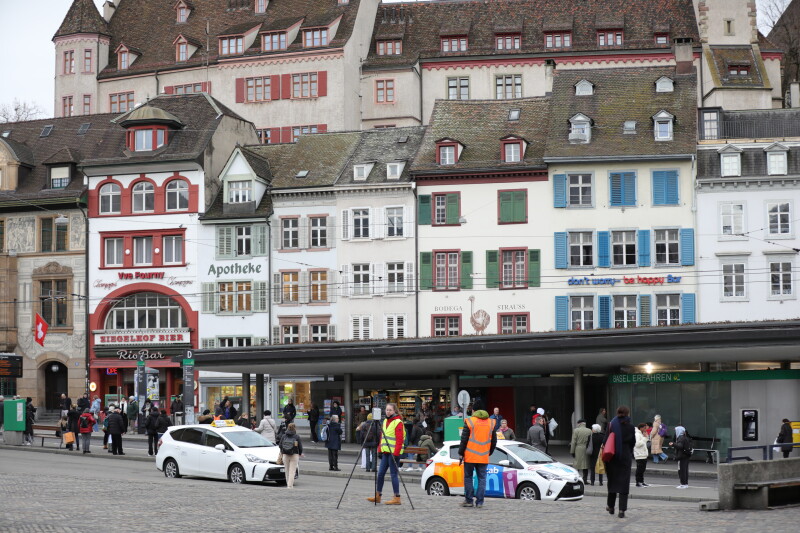Contributed by Manuel Huber, via Hexagon and FHNW
The Barfuesser square (Barfüsserplatz) is the heart of Basel city. Eight tram lines converge here, and famous bars surround the square. Markets and festivals take place throughout the year, and the Swiss football club FC Basel celebrates its title wins here. The “Barfi,” as locals call it affectionately, has grown historically. It is a place full of life — but also obstacles. The steps, edges, tram rails and cobblestone pavement are stumbling blocks or insurmountable obstacles for people with limited mobility.
Natalie Berger, Head of the Department for the Rights of People with Disabilities at the Canton of Basel City, says: "The Barfi is a central area for Basel with significant social importance. As such, it's also a crucial space for the social inclusion of people with disabilities.”
This made the square an ideal location for the DigitalCities4Us project — a collaborative endeavour between the Canton of Basel City, the University of Applied Sciences and Arts Northwestern Switzerland (FHNW) and Hexagon to create high-resolution digital city models for structural planning and the development of barrier-free cities.
The city of Basel was open to DigitalCities4Us right from the start. “The city plans to redesign in the coming years. The Canton of Basel City wants to provide high-quality public spaces for all its residents, including those with disabilities," Berger continued.
A holistic understanding of inclusion
The Swiss Disability Equality Act came into effect in 2004. This federal act aims to eliminate and prevent discrimination against people with disabilities. Its goal is to enable them to participate fully in social activities and live independently — for example, by ensuring access to barrier-free public transport.
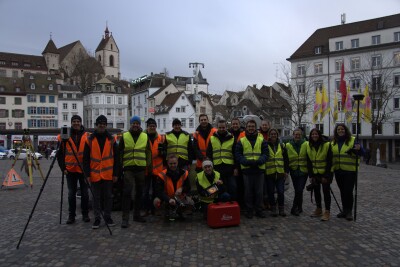
Meeting legal requirements can be challenging for cantons and municipalities. Cities like Basel have continuously adjusted and optimised public buildings and infrastructure, but more effort is needed to achieve true inclusion.
Professor Dr. David Grimm from FHNW agrees: “It is not enough that people with limited mobility can get off the tram on their own at the newly designed tram stop at Barfüsserplatz if they can't progress any further. The DigitalCities4Us project aims to demonstrate how these challenges can be addressed using a high-resolution digital replica of a specific location.”
Millimetre precise data as a basis
"The DigitalCities4Us project allows us to test, in a practical way, whether a planned route from A to B is accessible for a person with specific individual needs. At the same time, we identify where infrastructure improvements would be most effective and beneficial,” explains Grimm.
The basis for this is millimetre-precise data that accurately maps structures such as edges, thresholds or floor coverings, adds Romy Maunz, Director Business Development at Hexagon’s Geosystems division: "A high degree of accuracy is essential to obtain meaningful data and information that enables us to make reliable decisions." This level of precise data is provided by Hexagon’s technology. However, the company has been much more than just a supplier of the latest technologies, says Romy Maunz: “We support the project with our practical experience, technologies, methods and services for data capturing, processing, analysis and visualisation. We’re also making a financial contribution.
“Through our commitment, we want to show that the use of modern technologies and the data they generate creates value for society. We want to contribute to an inclusive community and foster collaboration among universities, industry and public administration."
Mapping Day with different solutions
The project team gained valuable insights during initial tests on one specific street, at the Ruemelinsplatz in Basel. In late February 2024, they captured high-precision data of the Barfüsserplatz. For this, they used various Hexagon solutions and technologies, that differ in their measurement process, accuracy levels, technology and evaluation procedure. The rationale is that the project will compare the methodologies and technologies here to make recommendations for future projects.
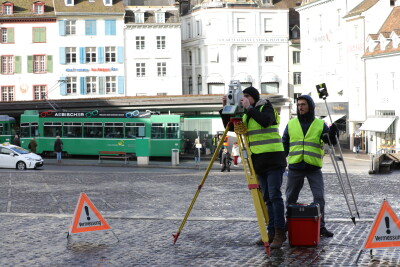
The project team wants to develop scalable methods for utilising high-resolution digital city models for architectural planning and the development of barrier-free cities. To do this, staff and students from FHNW, supported by Hexagon experts, captured the Barfi and its surrounding area using the Leica Pegasus TRK500 Neo mobile mapping system and the Leica BLK2FLY airborne laser scanner. Additionally, they used the Leica RTC360 terrestrial laser scanner.
To maintain spatial accuracy and consistency, the point clouds were georeferenced using about 20 scan target marks distributed around the square and measured using the Leica MS60 MultiStation. The city of Basel has numerous high-precision survey points.
Three-dimensional image with five billion points
Each solution revealed different advantages, says Grimm: “The autonomous flying laser scanner, for instance, provides a different perspective on objects and is suited to scanning an area as autonomously as possible. The terrestrial scanner, on the other hand, offers excellent data quality in terms of accuracy and spatial resolution. This scanner can recognise objects as small as a few millimetres.”
This precision is important, for example, in determining the roughness of cobblestone squares. The data can be used to predict rolling resistance and vibrations experienced when traversing the areas in a wheelchair or pushchair.
Data acquisition is highly efficient, and the captured data can be verified on-site in real time. By combining these solutions and the collective expertise of everyone involved, a millimetre-precise, three-dimensional replica of Barfüsserplatz was created in the form of a data cloud comprising of five billion measurement points.
New opportunities for sustainable urban development
“The digital replica, or digital twin, enables us to address specific challenges and support intelligent, sustainable initiatives,” explains Hexagon’s Romy Maunz. “This can enhance the quality of life, safety and sustainability of a city or municipality.”
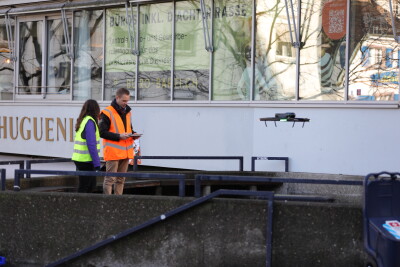
Detailed 3D information about urban spaces also unlocks new possibilities for planning inclusive cities — a key goal for the Canton of Basel-Stadt, says Natalie Berger: “We hope this project will provide a robust data foundation, so we can make better decisions that incorporate the diverse needs of public space users, in line with the principles of universal design.
“Universal design means that products, environments, programmes and services are usable by all people. For wheelchairs users and those with limited mobility, for example, it is important to minimise walking distances, provide smooth surfaces and step-free crossings. For the visually impaired, tactile orientation cues are essential.”
High data quality is essential
The high-precision data is now being analysed and processed using Hexagon software. Some of these tools are AI-driven, capable of classifying objects and land cover, creating digital twins, simulating scenarios and generating specific action recommendations.
Grimm and his team analyse the 3D data in several stages, using it to examine how people with different mobility impairments can get from one location to another. “The initial results are very promising and show that the high-quality data is both useful and necessary,” says Prof. Dr David Grimm. “It’s also clear that accurately capturing specific locations is highly effective.”
This raises the question of whether the entire city of Basel ultimately needs to be surveyed and digitised with such high precision. However, according to Prof. Dr David Grimm, that is not the goal. “The Canton of Basel-Stadt is developing a digital twin of the entire city area. However, it is not as precise or detailed as the data foundation from the DigitalCities4Us project.” And that level of detail is not necessary for the whole city.
Public spaces like the city centre are particularly important for unrestricted accessibility. “The goal is to be able to refine the existing city-wide digital twin where needed, using simple methods in the future. This way, we can achieve results with much less effort, focussing only on areas where it is truly beneficial,” says Grimm.
Value for all partners
All partners describe the collaboration within the DigitalCities4Us project as constructive and valuable. They pursue meaningful goals, exchange ideas and mutually benefit from each other’s expertise and experience. Grimm emphasises its importance for FHNW: "As a university of applied sciences, we depend on external funding for all our research projects. Hexagon not only makes this project possible for us but also gives us access to the latest technologies that we would not have otherwise."
Natalie Berger from the Canton of Basel City speaks of a "professional, pleasant and productive" collaboration. "It is important for us that the results are actionable. That’s why we appreciate the practice-oriented research approach."
The project is slated for completion in 2025. Then the authorities and policymakers of the Canton of Basel City will be tasked to implement impactful measures, based on the project’s actionable recommendations, to foster an inclusive city — including for the Barfi, with its high social significance.
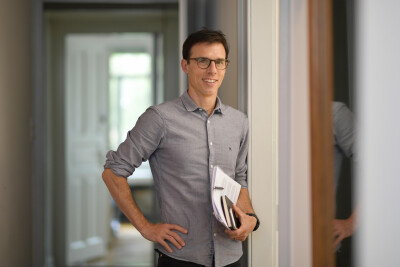 Manuel Huber is a communication specialist and copywriter with a diverse background in journalism and marketing. His career has spanned roles from radio editor to marketing manager, and he has been self-employed since 2009. Huber is actively involved in professional organizations and events, serving as a board member of the Central Swiss Public Relations Society. He is co-author of the specialist publication People make brands.
Manuel Huber is a communication specialist and copywriter with a diverse background in journalism and marketing. His career has spanned roles from radio editor to marketing manager, and he has been self-employed since 2009. Huber is actively involved in professional organizations and events, serving as a board member of the Central Swiss Public Relations Society. He is co-author of the specialist publication People make brands.




